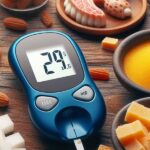T1D Series: Navigating the Landscape of Type 1 Diabetes in India: Understanding Genetics, Social Challenges, and Family Dynamics

Type 1 diabetes mellitus (T1DM) is an autoimmune disease that results in the destruction of beta cells that produce insulin in the pancreas.1,2 The development of this T1D is affected by a combination of genetic predisposition and environmental factors.1,3,4
Genetic Predisposition
The development of Type 1 Diabetes Mellitus (T1DM) is significantly influenced by genetic predisposition.3,4 It is not a single gene that determines the risk, but rather a combination of genes.3 The most significant genetic determinants are found in the human leukocyte antigen (HLA) regions, contributing to 40-50% of the genetic risk.3 Other genes, including INS, also contribute to disease risk.3
Family history is another important factor. If a parent has T1DM, the child’s risk increases.5 For instance, if a man has T1DM, the odds of his child developing the disease are 1 in 17.3 If a woman with T1DM gives birth before the age of 25, her child’s risk is 1 in 25; if she gives birth after turning 25, the risk decreases to 1 in 100.3
Molecular Mechanisms
The molecular mechanisms involved in T1DM are complex and multifaceted. From an epigenetic standpoint, mechanisms such as DNA methylation, histone modification, microRNA, and molecular mimicry may play a role.1,6 These mechanisms regulate gene expression, affecting the immune system’s response to islet beta cells.1,6
T1DM is characterized by the recognition of islet autoantigens by autoreactive CD4+ and CD8+ T cells and autoantibodies.1 Autoantibodies against islet autoantigens are involved in autoantigen processing and presentation by HLA molecules.1
In most cases of T1DM, individuals must inherit risk factors from both parents.1 These factors are more common in white people, who have the highest rate of T1D.1 Despite this, most people at risk do not develop diabetes, leading researchers to investigate potential environmental triggers.1
One of the characteristics of T1DM is the recognition of islet autoantigens by autoreactive CD4+ and CD8+ T cells and autoantibodies.3 Autoantibodies against islet autoantigens are involved in autoantigen processing and presentation by HLA molecules.3
In conclusion, T1DM is a complex disease influenced by both genetic predisposition and molecular mechanisms. Understanding these factors can help in the development of predictive biomarkers and personalized therapies, ultimately aiming to prevent or reverse the development of the disease.2
References:
- Genetics of Diabetes | ADA. American Diabetes Association. Accessed April 13, 2024. https://diabetes.org/about-diabetes/genetics-diabetes
- Is Type 1 Diabetes Genetic? Research and More. Healthline. Accessed April 13, 2024. https://www.healthline.com/health/diabetes/is-type-1-diabetes-genetic
- Xie Z, Chang C, Zhou Z. Molecular mechanisms in autoimmune type 1 diabetes: a critical review. Clin Rev Allergy Immunol. 2014;47(2):174-192.
- Zajec A, Trebušak Podkrajšek K, Tesovnik T, et al. Pathogenesis of Type 1 Diabetes: Established Facts and New Insights. Genes (Basel). 2022;13(4):706.
- Kelly MA, Rayner ML, Mijovic CH, Barnett AH. Molecular aspects of type 1 diabetes. Mol Pathol. 2003;56(1):1-10.
- Research spotlight – what causes Type 1 diabetes? Diabetes UK. Accessed April 13, 2024. https://www.diabetes.org.uk/our-research/about-our-research/hot-topics/what-causes-type-1


